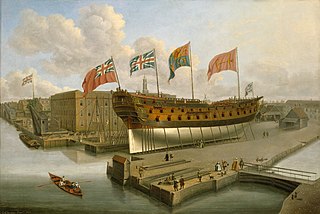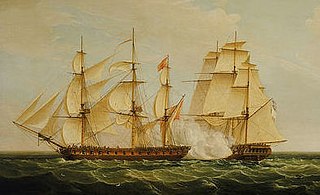HMS Trepassey, often spelled "Trepassy", was a 14-gun brig-sloop of the Royal Navy, formerly the American privateer Wildcat, launched and captured in 1779. The Royal Navy purchased her in 1779. USS Alliance captured Trepassey in 1781. She became the American merchant vessel Defence. In 1782 HMS Jason captured Defense, which the Royal Navy took back into service under her earlier name. The Navy sold her in 1784.

HMS Buckingham was a 70-gun third-rate ship of the line of the Royal Navy, built at Deptford Dockyard by John Holland to the draught specified by the 1745 Establishment, and in active service during the Seven Years' War with France. With a crew of 520 she was one of the largest ships in the Navy at that time.

HMS Badger was a brig rigged Sloop-of-War in service with the Royal Navy in the late eighteenth century. She was the first Royal Navy ship to be commanded by Horatio Nelson.

Sir Charles Henry Knowles, 2nd Baronet, GCB was an officer of the Royal Navy, who saw service during the American War of Independence, and the French Revolutionary and Napoleonic Wars, eventually rising to the rank of Admiral. He was an extraordinary figure and a great tactical innovator. Highly intellectual, he authored a number of signal books and had the chance to put his ideas into practice during his naval career. Knowles was at times beset by problems with discipline aboard his ships, often due to large proportions of raw recruits and untrained seamen. This may have been a factor in his rocky relationship with his superior, Sir John Jervis, which eventually led to Knowles's retirement from active service after the Battle of Cape St Vincent, and his concentration on scholarly studies of the issues affecting the naval service.

HMS Porcupine was a 24-gun Porcupine-class sixth-rate post ship of the Royal Navy built in 1777 and broken up in 1805. During her career she saw service in the American War of Independence and the French Revolutionary Wars.

The action of 8 January 1780 was a naval encounter off Cape Finisterre between a British Royal Naval fleet under Admiral Sir George Rodney, and a fleet of Spanish merchants sailing in convoy with seven warships of the Caracas Company, under the command of Commodore Don Juan Augustin de Yardi. During the action the entire Spanish convoy was captured. Rodney's fleet was en route to relieve Gibraltar, and this action took place several days before Rodney's engagement and defeat of a Spanish fleet at the Battle of Cape St. Vincent.
HMS Montreal was a 32-gun Niger-class fifth-rate frigate of the Royal Navy. She was launched in 1761 and served in the Seven Years' War and the American War of Independence. The French captured her in 1779 and she then served with them under the name Montréal. An Anglo-Spanish force destroyed her during the occupation of Toulon early in the French Revolutionary Wars.

Charles Inglis was an officer of the Royal Navy who saw service during the War of the Austrian Succession, the Seven Years' War, and the American War of Independence, rising to the rank of rear-admiral.

HMS Prince William was a 64-gun third-rate ship of the line of the Royal Navy. She had previously been Nuestra Señora de la Asunción, but was better known as Guipuzcoano, an armed merchantmen of the Spanish Basque Guipuzcoan Company of Caracas.

HMS Surprise was a 28-gun Enterprise-class sixth-rate frigate of the Royal Navy, which served throughout the American Revolutionary War and was broken up in 1783.

HMS Crescent was a 28-gun Enterprise-class sixth-rate frigate of the Royal Navy. Crescent was launched in 1779. The French captured her in 1781. She was wrecked in 1786.

HMS Pearl was a fifth-rate, 32-gun British Royal Navy frigate of the Niger-class. Launched at Chatham Dockyard in 1762, she served in British North America until January 1773, when she sailed to England for repairs. Returning to North America in March 1776, to fight in the American Revolutionary War, Pearl escorted the transports which landed troops in Kip's Bay that September. Much of the following year was spent on the Delaware River where she took part in the Battle of Red Bank in October. Towards the end of 1777, Pearl joined Vice-Admiral Richard Howe's fleet in Narragansett Bay and was still there when the French fleet arrived and began an attack on British positions. Both fleets were forced to retire due to bad weather and the action was inconclusive. Pearl was then despatched to keep an eye on the French fleet, which had been driven into Boston.
Several vessels of the British Royal Navy have borne the name HMS Minorca, for the island of Menorca, which the British called "Minorca":
HMS Pochahontas was the Virginia letter of marque Pocahontas, launched in 1777. The British Royal Navy captured her in 1780. She participated in the battle of Fort Royal, Martinique, in April 1781. In May she was renamed Pachahunta. The Navy sold her at Jamaica in 1782.
Governor Trumbull was launched at Norwich, Connecticut in 1777 as a purpose-built privateer. There is no record of her having captured any British vessels but she did raid Tobago in 1779. The Royal Navy captured her shortly thereafter and took her into service as HMS Tobago. she served in the Leeward Islands until the Navy sold her in 1783, probably at Jamaica. She was apparently wrecked on 16 August 1787 at Tobago.
HMS Gibraltar was a Royal Navy brig, formerly the American brig Virginia. The Royal Navy acquired Gibraltar in 1779 and in May commissioned her under Lieutenant Almerick Brown. The Spanish captured her in the Mediterranean in 1781 and named her San Salvador.
HMS Keppel was the American privateer brig New Broome, of New Haven, Connecticut, that Ariel and Savage captured on 21 October 1778. She was sold on 5 August 1783 at Boston.

The Capture of HMS St Fermin was a naval engagement that took place off Málaga on 4 April 1781, during the American Revolutionary War. Spanish xebecs San Antonio and San Luis captured the sloop-of-war HMS St Fermin.

HMS Fury was a Swan class ship sloop of the Royal Navy and was launched in March 1779. She performed mainly anti-privateering duties during the American War of Independence, both in the English Channel and later the Caribbean Sea. She had a short service life, being paid off after less than 5 years service and broken up 3 years after that, but did have notable commanders.












